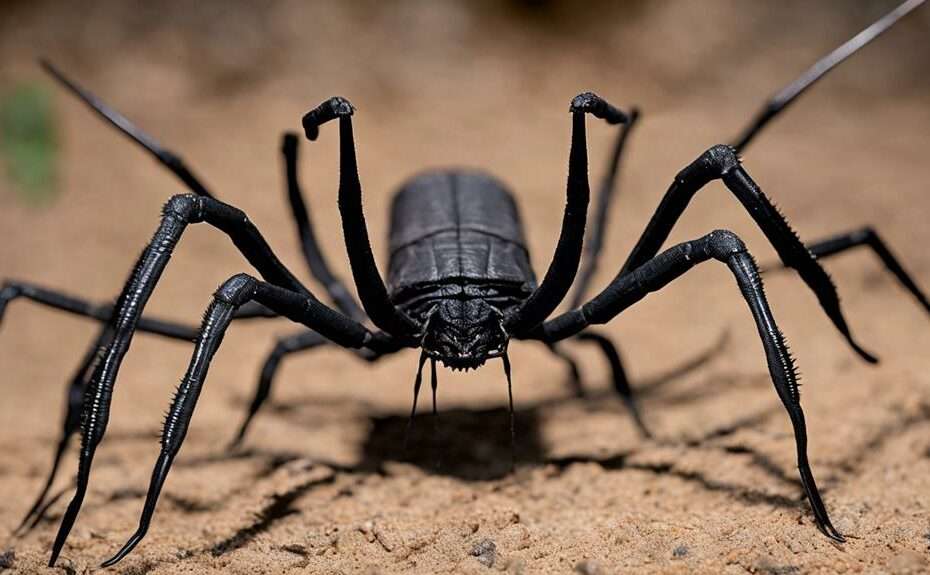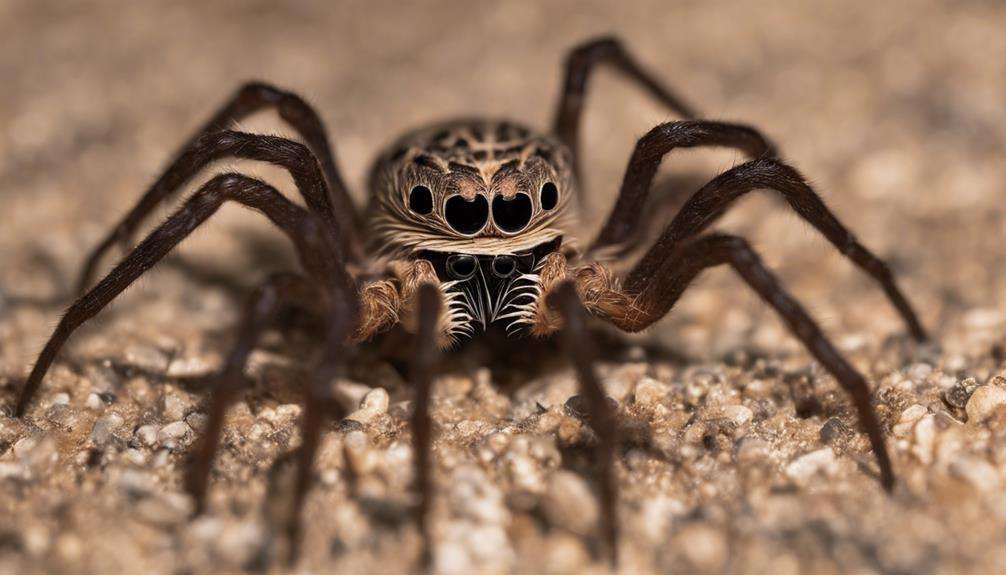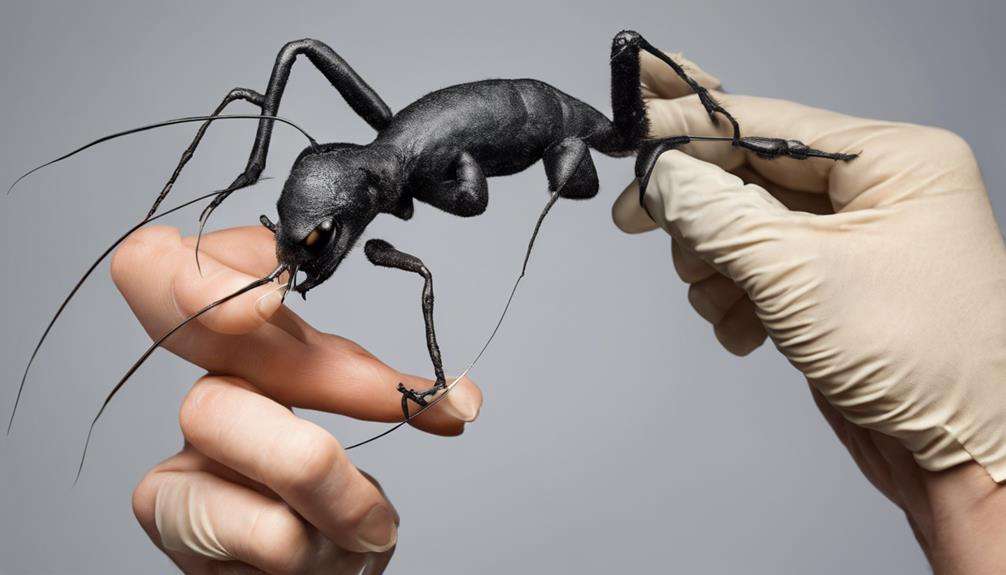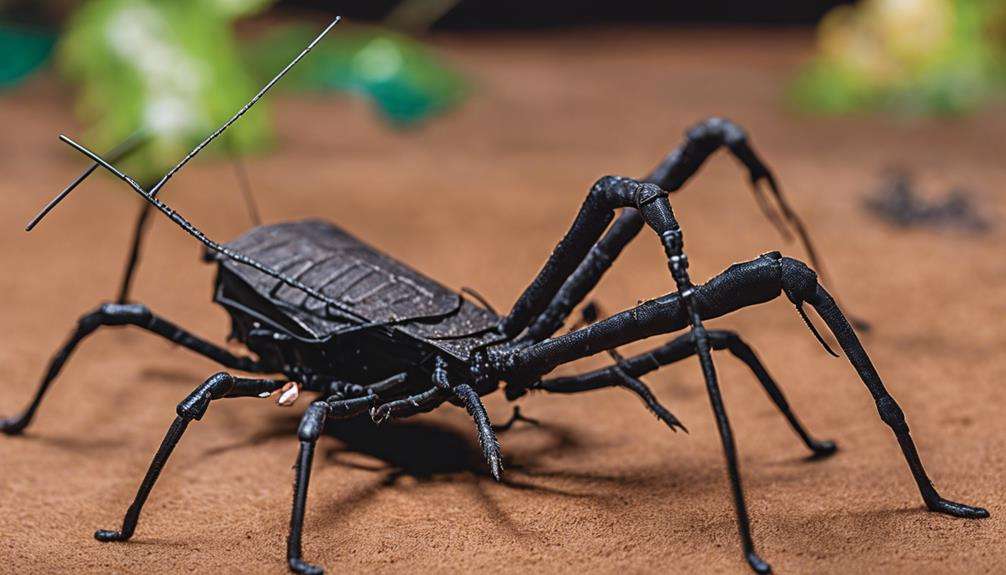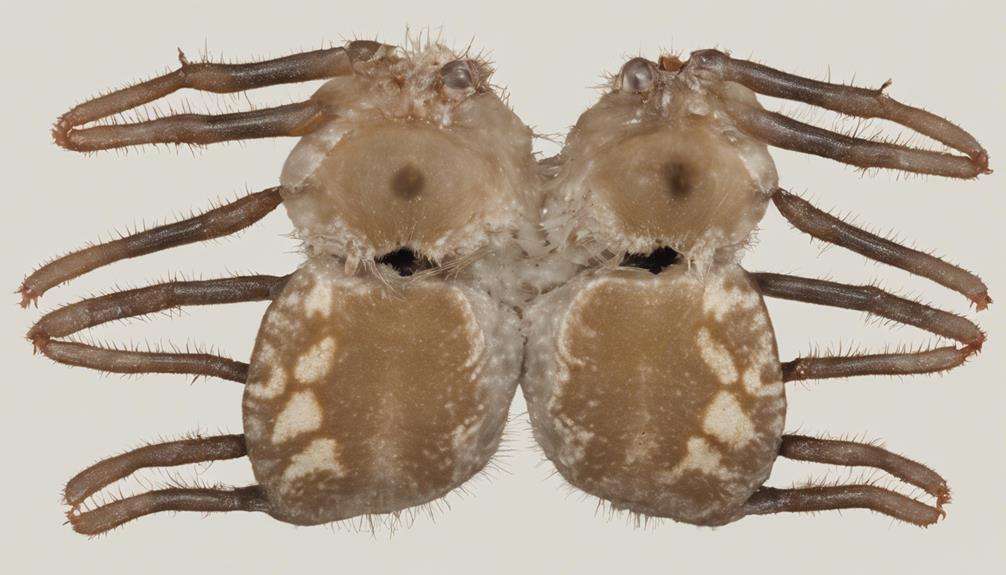In a world where the familiar traits of scorpions are reimagined, tailless whip scorpions stand out as intriguing creatures with a unique twist.
As you explore the realm of these ancient arachnids, you'll uncover surprising facts that challenge conventional beliefs.
From their sideways crab-like movements to the mysterious chirping sounds they emit, each detail adds to their enigmatic nature.
Stay tuned to discover the fascinating world of tailless whip scorpions and their seven best-kept secrets.
Key Takeaways
- Tailless whip scorpions excel in ambush hunting strategies.
- Their chirping communication enhances social interactions.
- Specialized legs aid in precise movement and sensory perception.
- Crab-like locomotion and unique sensory adaptations distinguish them.
Amblypygids Vs. Scorpions
When comparing Amblypygids to scorpions, the absence of a telson or tail in tailless whip scorpions distinguishes them from true scorpions. Amblypygids, also known as tailless whip scorpions, exhibit this distinctive feature, making them easily recognizable. Unlike scorpions, which possess a venomous sting located at the end of their tail, amblypygids lack this appendage altogether. This physical difference is crucial in separating the two arachnid groups.
Furthermore, in terms of physical features, tailless whip scorpions lack the venomous jaws and stingers that are characteristic of scorpions. Instead, amblypygids rely on their unique pedipalps to seize prey. These specialized front appendages aid in capturing and holding onto insects, small vertebrates, and other prey items. In contrast, scorpions primarily use their venomous stingers to subdue their victims.
Ancient Creatures on Earth
Tailless whip scorpions, as ancient creatures on Earth, have captivated researchers with their unique evolutionary adaptations and behaviors. Belonging to the ancient arachnid order Amblypygi, these fascinating creatures have a lineage that stretches back over 415 million years. Despite not being true scorpions or spiders, tailless whip scorpions have evolved distinct characteristics that set them apart from other arachnids. Over millions of years, they've developed intriguing behaviors, such as moving sideways like crabs to sense their surroundings and producing chirping sounds by rubbing their legs.
Unlike their web-spinning relatives, tailless whip scorpions rely on their front legs for navigation and hunting, showcasing a different approach to survival. Some species even exhibit social interactions through sensory legs, using these appendages as homing devices to navigate back to their homes. The ancient lineage and unique adaptations of tailless whip scorpions highlight their importance in understanding the evolutionary history of arachnids and the complex ecosystems they inhabit.
Sideways Travelers: Crab-like Movement
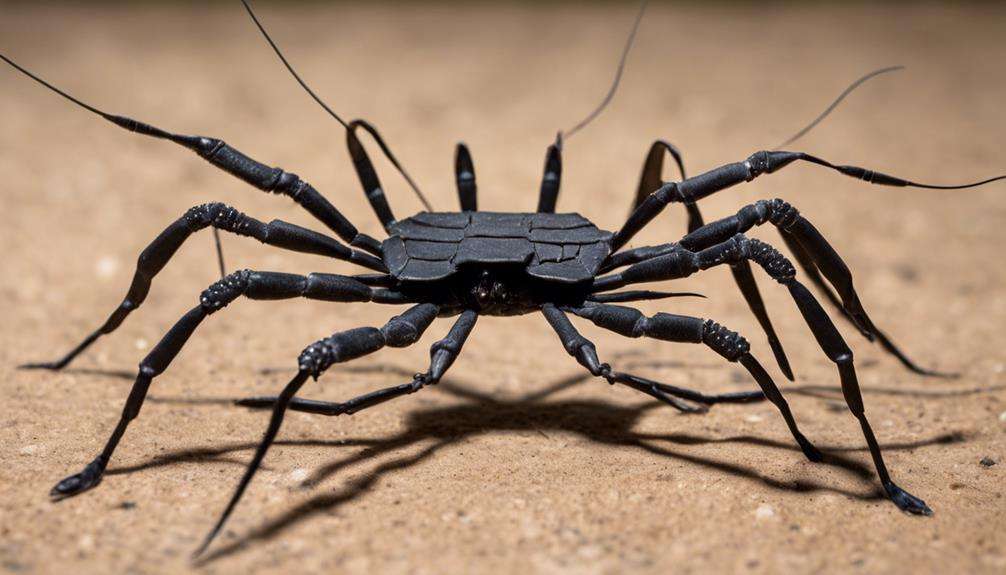
Tailless whip scorpions exhibit a crab-like locomotion style, utilizing sideways scuttling behavior to navigate their surroundings efficiently.
This unique movement adaptation allows them to explore their environment effectively, locating prey and shelter with precision.
Crab-Like Locomotion Style
Utilizing a crab-like locomotion style, tailless whip scorpions navigate their surroundings efficiently to locate prey and explore their habitat effectively. Their legs are crucial for this sideways movement, allowing them to move with agility and precision.
By adopting this unique crab-like locomotion, tailless whip scorpions can maintain a heightened sense of awareness, crucial for survival in their environment. This sideways movement enables them to scan their surroundings continuously, aiding in the hunt for food and ensuring they can react swiftly to potential threats.
The adaptation of crab-like locomotion in tailless whip scorpions showcases their remarkable ability to thrive in their natural habitat through specialized movement strategies.
Sideways Scuttling Behavior
With their distinctive sideways scuttling behavior, tailless whip scorpions showcase a crab-like movement style that enhances their ability to sense and navigate their surroundings efficiently. This unique feature allows them to move swiftly and stealthily, aiding in hunting and survival.
By scuttling sideways, these creatures exhibit remarkable adaptability in various habitats. This sideways travel isn't just a form of locomotion but a strategic advantage, helping them locate prey without heavily relying on sight.
Tailless whip scorpions' ability to move sideways sets them apart from other arachnids, showcasing their agility and specialized adaptation for maneuvering in diverse environments.
Next, we'll delve deeper into their Unique Movement Adaptations, further highlighting their exceptional capabilities.
Unique Movement Adaptations
Employing a sideways scuttling behavior reminiscent of crabs, tailless whip scorpions exhibit a unique movement adaptation that enhances their environmental awareness and navigational capabilities. This species of whip scorpions utilizes this distinctive sideways movement to sense their surroundings effectively and navigate through their habitat with agility.
By moving laterally like crabs, tailless whip scorpions can explore their environment efficiently, relying less on visual cues. This adaptation not only helps them avoid potential threats but also aids in locating prey. The specialized legs of tailless whip scorpions play a crucial role in executing this crab-like movement, showcasing their remarkable flexibility and adaptability.
Observing these unique movement adaptations provides valuable insights into the evolutionary strategies these creatures have developed for survival in their ecosystems.
No Webs for These Arachnids
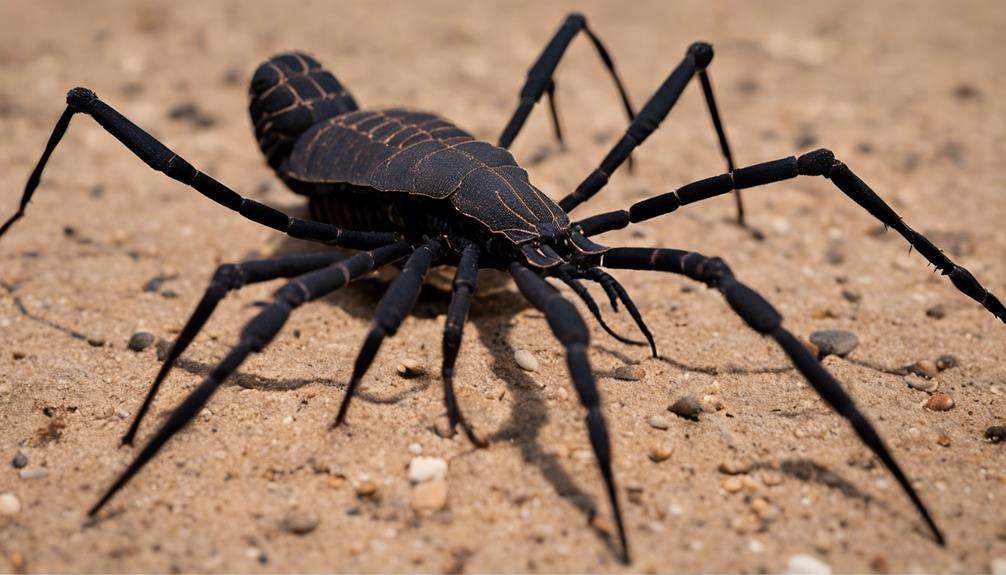
Tailless whip scorpions stand out among arachnids for their lack of web-spinning abilities. Instead, they rely on unique hunting techniques, using their agility and speed to capture prey.
These solitary nocturnal predators often employ ambush strategies in caves, showcasing their specialized adaptations for hunting without the need for webs.
Unique Hunting Techniques
Utilizing their agile and swift movements alongside specialized appendages, tailless whip scorpions employ unique hunting techniques that set them apart from other arachnids. Unlike spiders that rely on webs for trapping prey, these arachnids use their thorny-edged pedipalps to seize and subdue their victims swiftly.
Their third pair of elongated, whiplike appendages act as sensory tools, aiding in detecting and capturing prey effectively. Tailless whip scorpions showcase adaptability and prowess as active predators in their environment, demonstrating a remarkable ability to hunt without the need for stationary traps.
Their hunting strategies highlight a blend of speed, precision, and specialized anatomy that make them formidable hunters in the dark crevices where they dwell.
Solitary Nocturnal Predators
Solitary nocturnal predators, tailless whip scorpions exhibit remarkable hunting behaviors distinct from arachnids that rely on webs for trapping prey. These arachnids are solitary creatures that actively hunt for prey under the cover of darkness, using their adept movements and acute senses to secure food.
They don't construct webs but instead rely on their thorny-edged pedipalps to seize and subdue their unsuspecting victims. While hiding under bark or stones during the day, tailless whip scorpions emerge at night to forage for a variety of prey, including insects and small vertebrates. Their role as nocturnal predators plays a crucial part in maintaining ecosystem balance by controlling insect populations and providing sustenance for larger predators.
- Solitary nocturnal hunters
- Agile movements and keen senses
- Thorny-edged pedipalps for hunting
Ambush Predators in Caves
In dark, remote caverns, these skilled arachnids employ stealth and agility as ambush predators, eschewing web-spinning for capturing prey with precision. Tailless whip scorpions, lacking traditional webs, rely on their long front legs to grab and immobilize unsuspecting victims.
Their thorny-edged pedipalps serve as effective tools to skewer and subdue a variety of prey, from insects to small vertebrates. Adapted to hunt in the dark, these arachnids excel as ambush predators in caves, utilizing their keen sensory organs to detect movement and locate potential meals.
Chirping Tailless Whip Scorpions
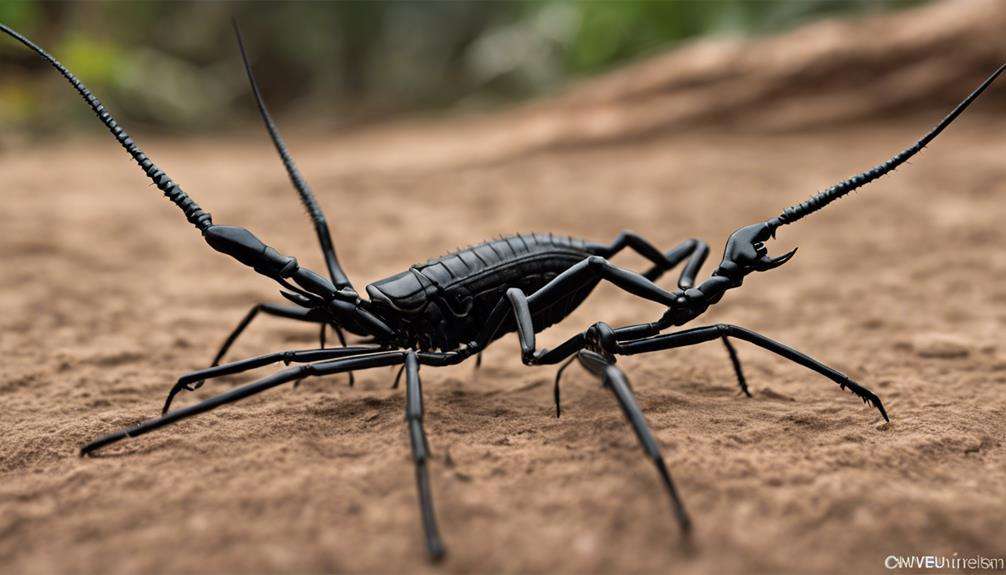
Tailless whip scorpions exhibit a unique ability to produce chirping sounds by rubbing their legs together, serving as a form of communication, particularly during interactions with other tailless whip scorpions. This chirping behavior is significant as it aids in various aspects of their lives, including mating rituals. Here are some intriguing facts about chirping tailless whip scorpions:
- Communication: The chirping sounds emitted by tailless whip scorpions are a vital form of communication, allowing them to interact and convey messages to one another.
- Mating Rituals: Chirping plays a crucial role in mating, with males using these sounds to attract females and establish their presence during courtship.
- Distinctive Feature: This unique ability to produce chirping sounds sets tailless whip scorpions apart from many other arachnid species, showcasing their complex communication system.
Observing these creatures chirping away during their interactions provides a fascinating insight into the world of tailless whip scorpions and their intricate communication methods.
Almost Blind Amblypygids
Notably, possessing limited vision, amblypygids, including tailless whip scorpions, heavily rely on their front legs for navigation. These creatures, also known as Amblypygi, have distinctive antenniform legs that aid in feeling their way around their environment.
Despite having eight eyes, their vision is poor, and they primarily use their sensory legs to detect and explore their surroundings. This reliance on touch and sensory perception showcases their remarkable adaptation skills. Tailless whip scorpions, despite their visual impairment, exhibit impressive hunting abilities, capturing prey with precision in their habitats.
Their unique sensory capabilities highlight the evolutionary strategies that have allowed them to thrive. By honing their non-visual senses, these almost blind amblypygids have become efficient predators, showcasing the fascinating ways in which they've adapted to their environment.
The combination of limited vision and specialized sensory mechanisms makes them intriguing subjects for studying arachnid behavior and survival strategies.
Mating Rituals and Territory Battles
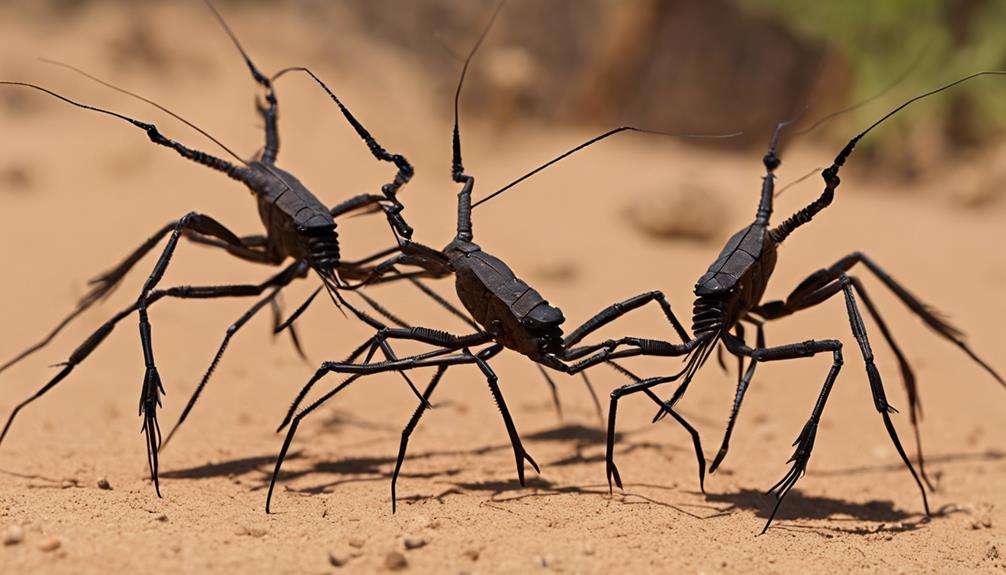
During their mating rituals and territorial battles, tailless whip scorpions exhibit intricate behaviors that highlight their unique survival strategies. When it comes to mating rituals, these arachnids engage in gentle courtship displays, showcasing unique behaviors to prevent aggression and ensure successful reproduction. Males employ a clever tactic during mating by securing their front pedipalps, preventing themselves from being consumed by females in the process.
- Survival Tactics: Males secure their front pedipalps during mating to avoid being eaten.
- Territorial Battles: Aggressive confrontations are common among tailless whip scorpions, with fierce fights determining the dominant individual.
- Sensory Legs: Some species of tailless whip scorpions utilize sensory legs for social interactions, displaying behaviors that go beyond mere survival instincts.
These arachnids also utilize their sensory legs as homing devices, showcasing impressive navigation skills by effectively finding their way back to shelters. The complexity of their mating rituals and territorial battles sheds light on the fascinating behaviors of tailless whip scorpions.
Frequently Asked Questions
What Are Some Interesting Facts About Whip Scorpions?
Tailless whip scorpions have fascinating traits. They inhabit dark, humid environments, with some species preferring caves. Males perform intricate courtship dances, displaying parental care. These skilled predators ambush prey, using their sensory legs to navigate and locate food sources efficiently.
Are Tailless Whip Scorpions Blind?
Yes, tailless whip scorpions are blind. Despite their lack of sight, they excel in hunting due to their predatory instincts. Their sensory adaptations, like specialized organs on their legs, enable them to navigate effectively and locate prey.
Can Tailless Whip Scorpion Bite?
Tailless whip scorpions cannot bite humans due to lacking venomous jaws. They pose no biting threat, making them safe to handle. Precautions include gentle handling to prevent harm. If bitten, clean the wound and seek medical advice promptly.
What Are the Characteristics of a Tailless Whip Scorpion?
If you ever encounter a tailless whip scorpion, you'll be amazed by its extraordinary leg span, nocturnal behavior, and unique anatomy. These agile arachnids are like night-time acrobats with their wide, flat bodies and flexible appendages.
Conclusion
Now that you've delved into the intriguing world of tailless whip scorpions, you've witnessed nature's marvels up close. These ancient creatures, resembling a blend of crab, spider, and scorpion, navigate their environment with grace and precision.
Like skilled dancers on a stage, they move sideways, producing melodious chirps and engaging in intricate mating rituals. In the realm of arachnids, tailless whip scorpions stand out as unique performers, captivating observers with their fascinating behaviors.
